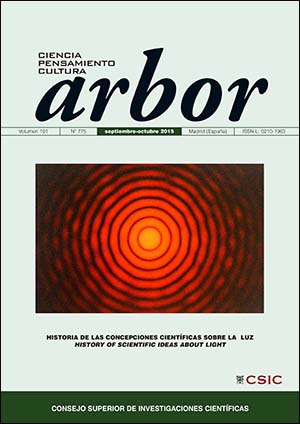Theories of the light and color in the Age of Enlightenment. From Newton to Goethe
DOI:
https://doi.org/10.3989/arbor.2015.775n5003Keywords:
Light, experimental philosophy, Newtonianism, metaphors, colours, cultural history of scienceAbstract
This article opens with a review of Isaac Newton’s theory of light, focusing on the controversial character of his crucial experiment. It then proceeds to examine certain aspects of his legacy in a century that was perhaps more Newtonian than his own optics. We analyse some of the metaphors connected with light and the symbolic role of light as the metaphor for knowledge. The article concludes with Goethe’s colour theory, his challenge to Newtonian theory, and his reinstatement of human beings and the history of science in order to achieve a better understanding not only of light, the eye and chromatic phenomena, but also of scientific activity as a whole.
Downloads
References
Amrine, F., Zucker, F. J. y Wheeler, H. (eds.) (1987). Goethe and the Sciences: a Reappraisal. Boston: Kluwer. http://dx.doi.org/10.1007/978-94-009-3761-1
Arnaldo, J. (ed.) (2008). Johann Wolfgang von Goethe. Paisajes. Madrid: Círculo de Bellas Artes.
Ball, P. (2003). La invención del color. Madrid: Turner.
Bennett, J., Cooper, M., Hunter, M. y Jardine, L. (2003). London's Leonardo: The Life and Work of Robert Hooke. Oxford: Oxford University Press.
Biagioli, M. (1994). Galileo, Courtier. The practice of Science in the Culture of Absolutism. Chicago: The University of Chicago Press.
Blumenberg, H, (1957/1993). Light as a Metaphor for Truth. At the Preliminary Stage of Philosophical Concept Formation. En Levin, D. M. Modernity and the hegemony of vision. Berkeley: University of California Press, pp. 30-62.
Cantor, G. (1983). Optics after Newton. Theories of Light in Britain and Ireland, 1704-1840. Manchester: Manchester University Press.
Collins, H. M. (1985). Changing Order. Replication and induction in scientific practice. Chicago: The University of Chicago Press.
Coopmans, C., Vertesi, J., Lynch, M. E. y Woolgar, S. (2014). Representation in Scientific Practice. Cambridge MA.: MIT. http://dx.doi.org/10.7551/mitpress/9780262525381.001.0001
D'Alembert, J. (1751/1984). Discurso preliminar de la Enciclopedia. Madrid: Sarpe.
Darrigol, O. (2012). A history of Optics from Greek Antiquity to the Nineteenth Century. Oxford: Oxford University Press.
Dobbs, B. J. T. y Jacob, M. C. (1995). Newton and the culture of Newtonianism. New Jersey: Humanities Press.
Goethe, J. W. (1810/1992) (ed. J. Arnaldo). Teoría de los colores. Murcia: Colegio Oficial de Arquitectos Técnicos de Murcia.
Goethe, J. W. (1790/1997) (ed. D. Sánchez Meca). Teoría de la Naturaleza. Madrid: Tecnos.
Guerlac, H. (1981). Newton on the Continent. Ithaca: Cornell University Press.
Hamilton, J. (1998). Turner and the scientists. London: Tate Publishing.
Hesse, M. (1966). Models and analogies in science. Notre Dame: Notre Dame University Press.
Hulme, P. y Jordanova, L. (1990). The Enlightenment and its shadows. London: Routledge.
Jacob, M. C. (1976). The Newtonians and the English Revolution, 1689-1720. Ithaca: Cornell University Press.
Klein, L. E. (2001). Enlightenment as conversation. En Baker, K. M. y Reill, P. H. (eds.). What's left of Enlightenment. Stanford: Stanford University Press, pp. 148-166.
Koyré, A. (1979). Del mundo cerrado al universo infinito. Madrid: Siglo XXI.
Lafuente, A., Valverde, N. y Pimentel, J. (2004). El telescopio de reflexión. Newton entre luces y cristales. Madrid: Consejo Superior de Investigaciones Científicas.
Leatherdale, W. H. (1974). The role of analogy, model and metaphor in science. Amsterdam: North-Holland.
Mabberley D. J. y San Pío, M. P. (2012). La carta de colores de Haenke de la Expedición Malaspina: un enigma. Madrid: Doce Calles.
Naydler, J. (ed.) (2002). Goethe y la ciencia. Madrid: Siruela.
Newton, I. (1704/1977) (ed. C. Solís). Óptica o Tratado de las reflexiones, refracciones, inflexiones y colores de la luz. Madrid: Alfaguara.
Nicolson, M. H. (1979). Newton demands the Muse. Newton's Opticks and the Eighteeenth Century Poets. Connecticut: Greenwood Press.
Pav, P. A. (1964). Eighteenth Century Optics. The Age of unenlightenment [Tesis doctoral inédita]. Indiana University: Indiana.
Pimentel, J. (1998). La física de la Monarquía. Ciencia y política en el pensamiento colonial de Alejandro Malaspina. Madrid: Doce Calles.
Pimentel, J. (2005). Entre el imperio vegetal y el sagrado enigma. Linneo, Goethe y el lenguaje de las plantas. En Olmos, R., Cabrera, P. y Montero, S. (eds.). El reino vegetal en el imaginario religioso del Mediterráneo. Madrid: Polifemo, pp. 297-320.
Richards, R. J. (2002). The romantic conception of life. Science and philosophy in the age of Goethe. Chicago: The University of Chicago Press. http://dx.doi.org/10.7208/chicago/9780226712185.001.0001
Schaffer, S. (2011). Trabajos de cristal. Los prismas de Newton y los usos del experimento. En Schaffer, S. Trabajos de cristal. Ensayos de historia de la ciencia. Madrid: Marcial Pons, pp. 75-121 [Trad. de Schaffer, S. (1989). Glass works: Newton's prisms and the uses of experiment. En Gooding, D., Pinch, T. y Schaffer, S. (eds.). The Uses of Experiment: studies in the natural sciences. Cambridge: Cambridge University Press, pp. 67-104].
Sepper, D. L. (1988), Goethe contra Newton. Polemics and the project for a new science of color, Cambridge: Cambridge University Press.
Published
How to Cite
Issue
Section
License
Copyright (c) 2015 Consejo Superior de Investigaciones Científicas (CSIC)

This work is licensed under a Creative Commons Attribution 4.0 International License.
© CSIC. Manuscripts published in both the printed and online versions of this Journal are the property of Consejo Superior de Investigaciones Científicas, and quoting this source is a requirement for any partial or full reproduction.
All contents of this electronic edition, except where otherwise noted, are distributed under a “Creative Commons Attribution 4.0 International” (CC BY 4.0) License. You may read the basic information and the legal text of the license. The indication of the CC BY 4.0 License must be expressly stated in this way when necessary.
Self-archiving in repositories, personal webpages or similar, of any version other than the published by the Editor, is not allowed.














